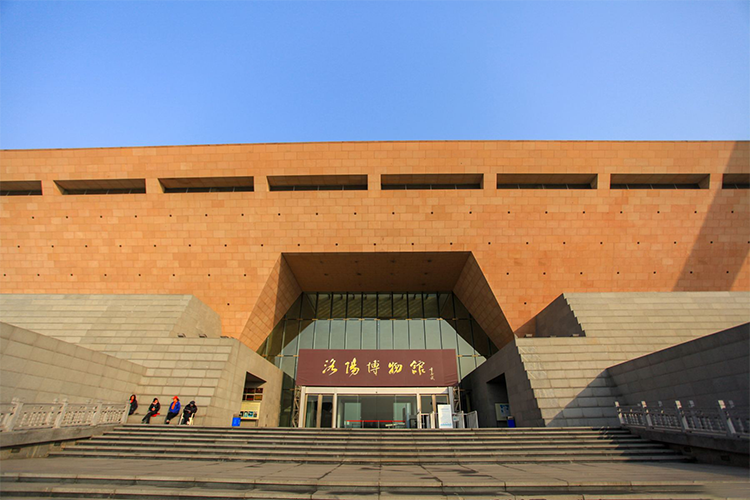Chinese Bronzes at Luoyang Museum: Visitor’s Guide to Ancient Treasures
Introduction
When the green patina of bronze catches Luoyang sunlight and a Tang sancai horse freezes mid-neigh, the building that rises like a ritual tripod becomes a key to China’s most brilliant chapters. Luoyang Museum tells a 3,000-year epic with 400,000 artifacts — not silent objects but warm witnesses inviting you to a cultural feast spanning from Xia and Shang to the Tang dynasty.
1. National Treasures: The Time Capsule of Thirteen Capitals
As one of China’s first national first-class museums, Luoyang Museum is arguably the best storyteller of Central Plains (He-Luo) civilization. Its unique role goes beyond collection: it is a microcosm of river-valley cultures. From bronzeware excavated at Erlitou to palace treasures from Wu Zetian’s reign, the museum preserves the genes of 13 dynasties that made Luoyang a capital (including Eastern Zhou, Eastern Han, Sui, and Tang). Its bronzes, tomb figurines, and Tang sancai ceramics are nationally renowned.
The new museum building, completed in 2011, is a contemporary masterpiece. Designed by the Tsinghua University School of Architecture, its monumental ding-like form and staggered bronze-clad facades echo bronze motifs. The central courtyard’s “river of history” water feature and the ceiling “Milky Way” lighting play off each other, illustrating the metaphor of a tripod presiding under a brilliant cosmos. Architectural Review praised it as a modern rewrite of Chinese traditional symbols.
2. Must-See Hallmarks: Face-to-Face with National Treasures
– Western Zhou Bronze Square Ding (Treasure Hall)
This nationally designated artifact cannot be taken out of the country. Its rare square form and fierce taotie decoration make it spectacular. A 20-character inscription on the inner wall records the Zhou royal conferral of rank — effectively a Shangshu-like record cast in bronze. The corner reliefs of kui-dragon patterns create a flowing optical effect under light, a peak of Western Zhou bronze-casting art.
– Tang Dynasty Black-Glazed Sancai Horse (Tang Sancai Hall)
One of only two in the world (the other is at the Tokyo National Museum). Its deep black glaze reflects Tang aristocratic taste for Western breeds. Remnants of gilding on the saddle suggest imperial ownership. Its muscular modeling conveys more dynamic power than even the famed Zhaoling Six Steeds.
– Eastern Han Stone Guardian (Stone Carving Hall)
This 1.8-meter tomb guardian bristles with detail: each feather of its wings bears Taoist cloud motifs, and beneath a raised forepaw is a carved subdued demon. Archaeologists see a mix of Persian winged beasts and Han prophetic thought, a living fossil of Silk Road cultural exchange.

3. Immersive Visit: The Best Route Through Five Themed Galleries
Quick Highlights (2 hours)
The core experience begins on the ground floor with the “He-Luo Civilization” gallery, a chronological display of some 2,000 years of selected masterpieces. Focus on:
– Xia dynasty jue with studded rim (one of China’s earliest bronze drinking vessels)
– Cao-Wei white jade cup (a social-media-famous find from Cao Cao’s tomb; minimalist elegance like modern art)
– Tang-era secret-color (miscolor) celadon with the legendary emerald hue
Deep Immersion (4+ hours)
Upstairs, themed galleries reward lingering:
– Han–Tang Tomb Figurines Hall: a spectacular procession of more than 200 painted figurines depicting an imperial entourage
– Stone Carving Hall: dedicated Northern Dynasties Buddhist statuary where you can compare the delicate “slender-boned” style with the vivid “wet-cloth” drapery technique
– Don’t miss temporary exhibitions — recent hits included “Grand Canal Treasures” and “Silk Road Jewels.”
4. Practical Guide: Visit Like a Local Museum Lover
Best times
Weekday mornings at opening are least crowded. Weekend afternoons often have free expert talks in Chinese. During the Peony Cultural Festival in April, book at least three days in advance.
Tips for foreign visitors
– English audio guide: CNY 30 rental, CNY 200 deposit; it covers roughly 80% of key pieces.
– Pick up an English map at the West service desk.
– Visa and Mastercard accepted for purchases, and Alipay users get a 10% discount on some services.
Architectural and hidden highlights
1. On the third floor main corridor, a glass floor reveals cross-sections of Luoyang’s urban stratigraphy.
2. Around 4 p.m., sunlight through the western perforated bronze façade projects a “bronze motif light carving” across the atrium.
3. The museum shop’s signature “Sancai Horse Gelato” (dark chocolate flavor) is a fun photo-op.
Nearby combination
Pair the museum with the Sui-Tang Luoyang City National Heritage Park (2 km away) — including the Yingtian Gate and Mingtang — for a complete day. See genuine artifacts in the morning and experience monumental urban archaeology in the afternoon; climb Yingtian Gate at dusk to watch the city lights.
Visitor essentials
Address: Nietai Road, Luolong District, Luoyang (near the north gate of the Sui-Tang City Ruins Botanical Garden)
Hours: 9:00–17:00 (last entry 16:30), closed Mondays
Admission: Free (exchange passport or Chinese ID for ticket); special exhibitions may charge
Transport: 8-minute walk from Metro Line 2 Wenboyuan Station, or take Bus 77 direct.

Conclusion
At Luoyang Museum, time is never purely linear — when you meet the tearful eyes of a sancai horse, the Tang spring seems to stir its mane; when your fingers brush a bronze ding’s cool edge, a Zhou priest might still be divining destiny. The museum preserves more than objects: it keeps the youthful memory of a nation. Use this guide and accept an appointment with three millennia of Chinese civilization.


